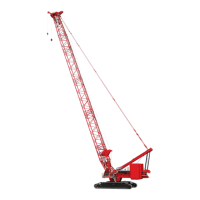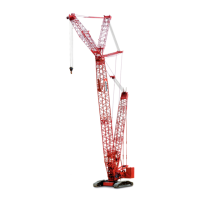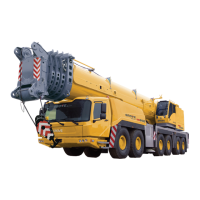Manitowoc Published 11-22-17, Control # 257-02 5-7
MLC300 SERVICE/MAINTENANCE MANUAL HOISTS
Drum 2 Hoisting Operation
The following conditions must be met to operate drum 2:
• Seat safety switch must be closed
• Drum 2 must be un-parked
When drum 2 joystick J4 is pulled back to hoist a load, the
CCM-10 control module sends a pulse-width modulated
(PWM) signal to the pump 1 electronic displacement control
(EDC). The PWM signal is in proportion to the speed
commanded by the joystick. Increasing the PWM duty cycle
increases the pump swashplate angle, which increases the
hydraulic flow from the B-side of the pump. From the pump,
hydraulic flow is routed to the B-side of the drum 2 motor.
At the same time, the CCMC11 control module shifts the
drum 2 brake release valve, allowing hydraulic fluid to flow
through the valve to the brake cylinder, releasing the drum
brake.
The CCM-10 control module then sends a signal to the
IOLC30 control module via the CAN Bus to ramp up the
PWM duty cycle to the drum 2 motor controller. Increasing
the PWM duty cycle decreases the swashplate angle in the
motor, which increases the motor flow until the rotational
speed is maximized based on the pump flow.
The drum 2 motor speed sensor and the pump 1 pressure
transducer provide closed-loop feedback to the controllers.
The control system uses this feedback to adjust the pump
and motor flows to maintain the speeds commanded by the
joystick.
Neutral
When drum 2 joystick J4 is moved back to neutral, the pump
swashplate shifts to neutral, stopping hydraulic flow in the
closed-loop circuit.
The motor swashplate then shifts to maximum displacement
and the drum 2 brake release solenoid valve is de-
energized. The de-energized solenoid valve vents hydraulic
brake pressure back to the tank, allowing spring force to
apply the drum brake.
Drum 2 Lowering Operation
The following conditions must be met to operate drum 2:
• Seat safety switch must be closed
• Drum 2 must be un-parked
When drum 2 joystick J4 is pushed forward to lower a load,
the CCM-10 control module sends a pulse-width modulated
(PWM) signal to the pump 1 electronic displacement control
(EDC). The PWM signal is in proportion to the speed
commanded by the joystick. Increasing the PWM duty cycle
increases the pump swashplate angle, which increases the
hydraulic flow from the A-side of the pump. From the pump,
hydraulic flow is routed to the A-side of the drum 2 motor.
At the same time, the CCMC11 control module shifts the
drum 2 brake release valve, allowing hydraulic fluid to flow
through the valve to the brake cylinder, releasing the drum
brake.
The CCM-10 control module then sends a signal to the
IOLC30 control module via the CAN Bus to ramp up the
PWM duty cycle to the drum 2 motor controller. Increasing
the PWM duty cycle decreases the swashplate angle in the
motor, which increases the motor flow until the rotational
speed is maximized based on the pump flow.
The drum 2 motor speed sensor and the pump 1 pressure
transducer provide closed-loop feedback to the controllers.
The control system uses this feedback to adjust the pump
and motor flows to maintain the speeds commanded by the
joystick.
When needed, the makeup check valve opens to allow
charge pressure fluid to enter the low pressure side of the
loop, thereby maintaining a positive pressure at the motor
port.
Drum 2 Loop Flushing
Loop flushing (cooling) is achieved by the continuous
exchange of hydraulic fluid through the loop flushing valve.
When the drum is operated in either direction, the sequence
valve opens at 21 bar (300 psi), allowing hydraulic fluid from
the loop to flow through the normally open poppet valve to
the flow control valve. The flow control valve removes
approximately 38 L/min (10 gpm) of hot hydraulic fluid from
the system by discharging the exhausted hydraulic fluid into
the motor case where the hydraulic fluid returns to the tank.
The accumulator in the loop flushing circuit protects the drum
motor from damage due to thermal expansion during
storage/transport. If the pressure in the motor increases, the
pressure is captured in the accumulator.

